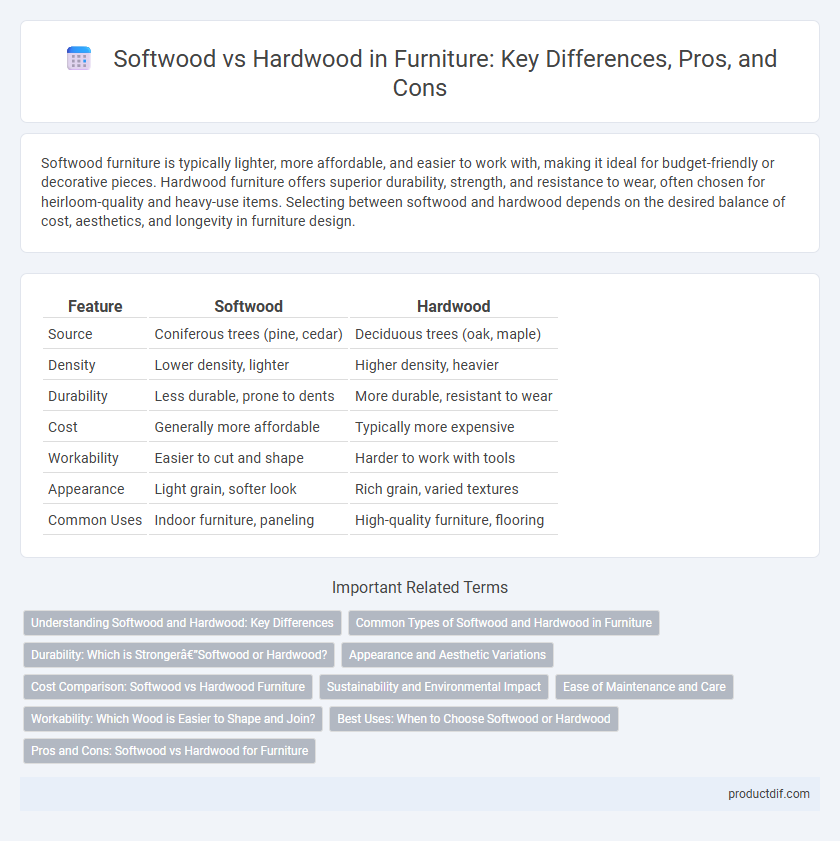Softwood furniture is typically lighter, more affordable, and easier to work with, making it ideal for budget-friendly or decorative pieces. Hardwood furniture offers superior durability, strength, and resistance to wear, often chosen for heirloom-quality and heavy-use items. Selecting between softwood and hardwood depends on the desired balance of cost, aesthetics, and longevity in furniture design.
Table of Comparison
| Feature | Softwood | Hardwood |
|---|---|---|
| Source | Coniferous trees (pine, cedar) | Deciduous trees (oak, maple) |
| Density | Lower density, lighter | Higher density, heavier |
| Durability | Less durable, prone to dents | More durable, resistant to wear |
| Cost | Generally more affordable | Typically more expensive |
| Workability | Easier to cut and shape | Harder to work with tools |
| Appearance | Light grain, softer look | Rich grain, varied textures |
| Common Uses | Indoor furniture, paneling | High-quality furniture, flooring |
Understanding Softwood and Hardwood: Key Differences
Softwood, derived from coniferous trees like pine and cedar, is generally lighter, more affordable, and easier to work with compared to hardwood, which comes from deciduous trees such as oak and maple. Hardwood offers greater durability and resistance to wear, making it ideal for high-quality furniture that requires longevity. The choice between softwood and hardwood directly impacts furniture's strength, appearance, and cost, highlighting the importance of understanding their distinct properties for optimal material selection.
Common Types of Softwood and Hardwood in Furniture
Common softwoods used in furniture include pine, cedar, fir, and spruce, known for their lightweight and affordability, making them suitable for casual or rustic pieces. Among hardwoods, oak, maple, cherry, and walnut are highly favored for their durability and rich grains, often chosen for high-quality, long-lasting furniture. The choice between softwood and hardwood impacts the furniture's strength, appearance, and price, influencing design and function in interior settings.
Durability: Which is Stronger—Softwood or Hardwood?
Hardwood, such as oak and maple, offers superior durability and strength compared to most softwoods like pine and cedar, making it ideal for heavy-use furniture. The dense cellular structure of hardwoods provides higher resistance to dents, scratches, and wear, ensuring longer-lasting pieces. Softwoods, while generally lighter and easier to work with, lack the hardness required for furniture subjected to frequent stress and impact.
Appearance and Aesthetic Variations
Softwood furniture often features lighter tones and a more uniform grain, creating a casual and airy aesthetic ideal for modern or rustic interiors. Hardwood furniture displays richer, deeper colors and intricate grain patterns, contributing to a luxurious and timeless appearance favored in traditional and high-end designs. Both wood types offer distinct aesthetic variations that significantly influence the overall style and mood of a space.
Cost Comparison: Softwood vs Hardwood Furniture
Softwood furniture generally costs less than hardwood furniture due to faster growth rates and greater availability of softwood species like pine and fir. Hardwood furniture, made from denser woods such as oak, maple, and walnut, carries a higher price tag reflecting its durability, rich grain patterns, and longer lifespan. Budget-conscious buyers often prefer softwood for affordability, while those prioritizing investment value and aesthetics tend to select hardwood options.
Sustainability and Environmental Impact
Softwood furniture typically comes from fast-growing trees such as pine and cedar, making it a more sustainable option due to quicker replenishment rates and lower carbon footprints. Hardwood, sourced from slower-growing trees like oak and maple, offers durability but often involves more significant environmental impact through extended growth cycles and deforestation risks. Choosing responsibly certified softwood or reclaimed hardwood can minimize ecological damage while maintaining quality and longevity in furniture production.
Ease of Maintenance and Care
Hardwood furniture, such as oak and maple, generally requires less frequent maintenance due to its dense grain, which resists scratches and dents more effectively than softwood varieties like pine or cedar. Softwood pieces often need regular sealing, waxing, or varnishing to protect against moisture and wear, making their upkeep more time-intensive. Choosing hardwood for furniture ensures greater durability and simplified care, ideal for long-term use in high-traffic areas.
Workability: Which Wood is Easier to Shape and Join?
Softwood is generally easier to shape and join due to its lower density and softer grain structure, making it ideal for intricate carvings and quick assembly in furniture making. Hardwood, with its dense and tight grain, offers superior strength and durability but requires more effort and specialized tools for cutting, shaping, and joining. Workability depends on project requirements, with softwood favored for ease and speed, and hardwood chosen for long-lasting structural integrity.
Best Uses: When to Choose Softwood or Hardwood
Softwood is ideal for construction, outdoor furniture, and decorative items due to its lightweight and ease of workability, making it suitable for projects requiring quick production and lower costs. Hardwood, known for its density and durability, is best chosen for high-traffic furniture pieces like dining tables, flooring, and cabinetry where strength and longevity are priorities. Selecting softwood or hardwood depends on the balance between budget, intended use, and the desired aesthetic and durability of the furniture.
Pros and Cons: Softwood vs Hardwood for Furniture
Softwood furniture offers affordability and easier workability, making it ideal for budget-conscious projects and intricate designs, but it lacks the durability and resistance to dents found in hardwoods. Hardwood furniture provides exceptional strength, longevity, and a rich, elegant appearance, though it tends to be more expensive and heavier to handle. Choosing between softwood and hardwood depends on balancing factors like cost, aesthetic preferences, and the desired lifespan of the furniture piece.
Softwood vs hardwood Infographic

 productdif.com
productdif.com